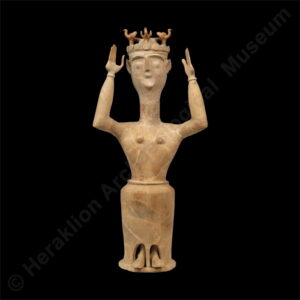
A type of female figure with raised arms, elbows bent at right angles in a distinctive gesture. Figures of this type consist of separate wheelmade parts (head, torso, cylindrical garment) joined together with clay. In some cases, the hem of the hollow cylindrical skirt is interrupted at front and back, revealing a pair of feet, also made separately. The largest figures are up to 85 cm tall. Besides the conventional gesture, many of the figures also display various symbols (birds, snakes, horns of consecration, poppy heads – see “Poppy Goddess”) attached to a diadem on their heads. In some cases the facial features are painted. Some figures have painted necklaces and bracelets, while some display coloured cloth bands on their bodies and other details. Figures of this type are mainly found in community sanctuaries of Postpalatial settlements (1300-1070 BC) and are believed to represent cult statues, priestesses or appearing goddesses. However, the range of symbols associated with the figures and the lack of standardisation in their iconography make a single interpretation difficult. Similar figures are also depicted on clay plaques with relief, appliqué or painted decoration, which, together with “snake tubes” and kalathoi, formed the basic equipment of the community shrines of the period.